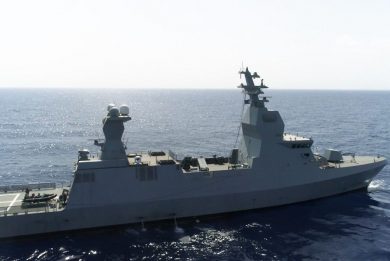
PAS19: Rafael upgrades in offensive and defensive capabilities
Acquiring the target and hitting it with utmost precision is the aim of an attack aircraft. Rafael Advanced Defense of Israel unveiled in Paris a series of improvements on its acquisition pods and on its effectors, which will considerably increase aircraft effectiveness.
The first step to carry out the mission is to acquire the target, and in the field of sensors Rafael has developed a series of pods, the Litening being the most popular in the world, with over 1900 units already in service, deployed by 27 different air forces. However having conquered over 50% of the targeting pod free market, its Litening flying on 25 types of aircraft, Rafael decided to further update its pod. While two years ago the Linening 5 performances were considerably increased, its colour sensor, medium and short wave IR sensors ensuring an acquisition capability at over 100 km, the 2019 edition of the Paris Air Show saw the unveiling of the Litening + SAR, the “+ SAR” indicating the addition of a new type of sensor in the form of a synthetic aperture radar. If the previous enhancement allowed providing extremely high resolution images at short range, which proved very useful in acquiring low signature targets in urban areas, the new one provides an all-weather capability, as it permits to operate over the clouds. The Litening pod is based on an open architecture to allow adding extra capabilities, and was designed with extra space and power to permit the easy insertion of new sensors without losing the electro-optical ones. The radar is provided by IAI Elta, the Israeli specialist in this field, the radar antenna and the processing unit easily finding their space inside the pod. According to Rafael this is only the first of the possible capability improvements of the company best-selling pod.

Once the target has been acquired, it must be destroyed. To this end the Haifa-based company has a number of solutions in its portfolio, among which the Spice family of standoff, autonomous, air-to-ground guidance kits, three being the members of that family, the Spice 2000, 1000 and 250. Considering the collateral damages problem and the need to be able to engage a variety of targets in a single mission, the Spice 250 is definitely on the top of the list of many air forces, as four of them can be carried on the Smart Quad Rack, ensuring the data link between the platform and the weapon even after launch, a key issue when chasing mobile targets. The Spice 250 can be fitted with a 75 kg class warhead and has a standoff range of 100 km. At the Paris exhibition Rafael introduced a new capability for the 250, in the form of the Automatic Target Acquisition (ATR), which adds to the existing guidance modes. Artificial intelligence and deep-learning technologies are used to allow the system to “learn” the specific target characteristics, based on a 3-D model. Prior to launch the pilot acquires the targets and allocate one of them to each of the weapons, which are then launched. They are directed towards the target area using the inertial guidance system, and then the ATR mode, based on autonomous electro-optic scene-matching algorithms, is automatically activated, allowing detection and recognition of each target. At this point the system allows fully autonomous operations, each weapon homing onto the defined target, or can be switched on the man-in-the-loop mode. The Spice 250 with the ATR mode is in the final development stage, the IOC being awaited before year end. Rafael has already bagged a first customer, the Israeli Air Force, which will start using it on the F-16. For other aircraft, among which the Eurofighter Typhoon, the company carried out a first check on computerised models.

Rafael is also fully involved in defending against incoming air threats. It is a partner in the Iron Dome and is fully involved in the system evolution to counter new threats such as UAVs and gliding bombs. A new mobile version, the i-Dome, allows carrying on a single truck the radar as well as 10 missiles, the battle management system being hosted in the cabin. The four-face AESA radar is fitted over the truck cabin, the system being radar agnostic, Rafael being ready to integrate sensors provided by different companies such as IAI, Rada, Thales and Raytheon. The radar is mounted on a mast allowing raising it higher than the launcher to ensure 360° coverage. The i-Dome is in the last phase of industrial development, a demonstration being planned before year end, Rafael being still in search of a launch customer.
Another by-product of the Iron Dome is the C- Dome, which has been procured by the Israeli Navy and installed on the Sa’ar 5 class ship, the system being also aimed at the Sa’ar 6, a 32 cell vertical launcher being installed on that ship.
Photos courtesy Rafael



